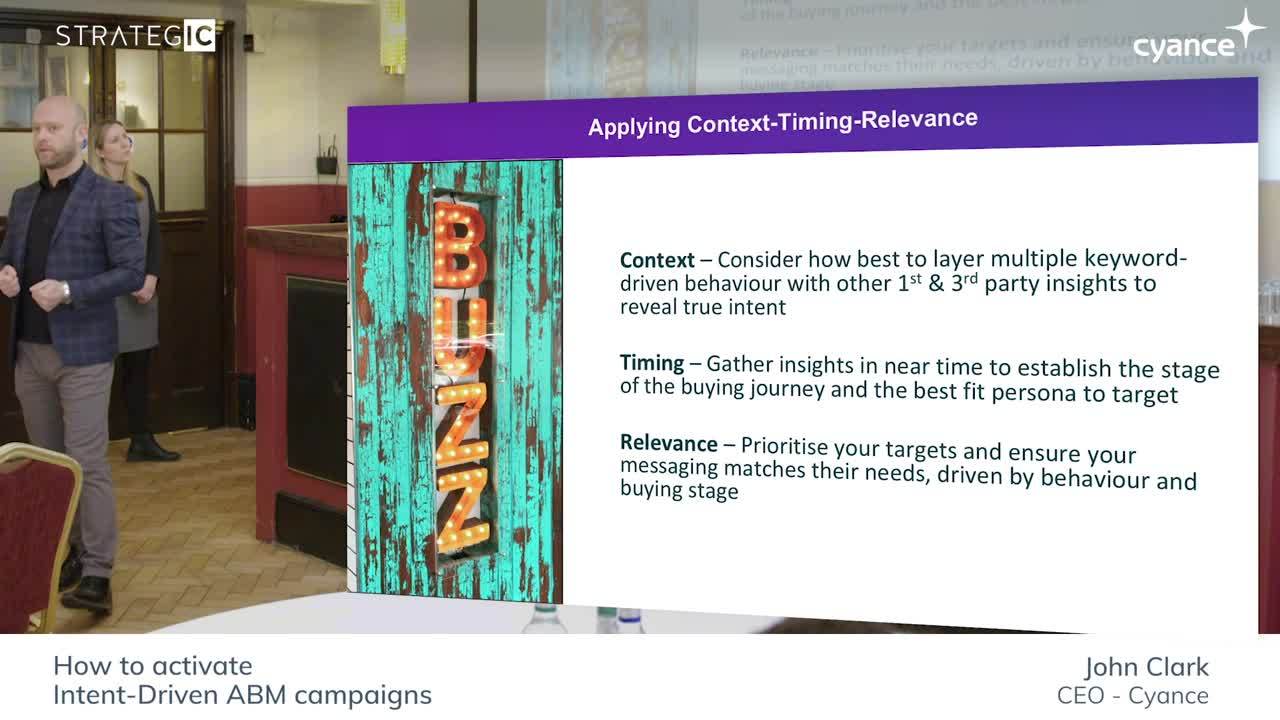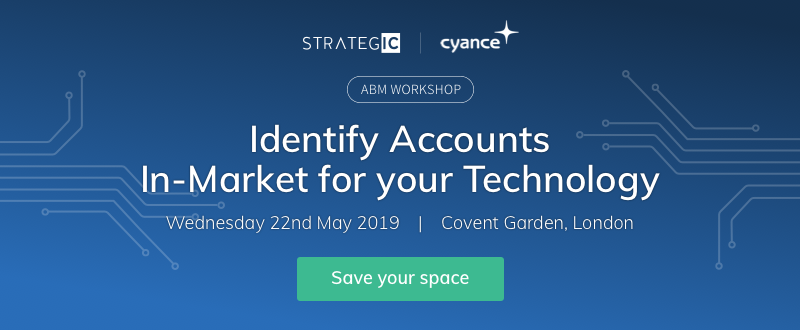What challenges do marketers face when trying to build intent-driven campaigns? And how can an intent solution deliver comprehensive value?
Intent-Driven Campaign Challenges and Solutions
In this video, taken from our March 2019 event, John Clarke CEO of B2B intent platform Cyance, explores common challenges that marketers face when looking to build intent-driven campaigns, and how an intent-model built on context, timing and relevance can deliver value.
Strategic CEO Alex Embling and Cyance CEO Jon Clark will outline more in our London ABM Workshop: Identify Accounts In-Market for your Technology on May 22nd. You can learn more, or sign up here.

What are the challenges we see when trying to build an intent-driven campaign?
Video Transcript
Typical challenges that we see include:
- How do you build an insight-led, behavioural driven, go-to-market strategy and campaign or set of campaigns?
- How do you have an always-on temperature check in terms of the total addressable market, to establish the active market?
- And how do you react not only to the market, but also customer needs quickly, to ensure you've got appropriate campaigns and content that's going to resonate and give you a better chance of converting more leads, generating more opportunities and ultimately empowering sales to be more effective in closing out those lead we [marketing] pass over to them.
[Looking at the solutions], firstly, this is why we say if you've got the right intent platform, and right intent capability, you should be able to access company-level buying intent that can provide behavioural insight on a number of different levels.
These include market view - looking at the macro view, looking at understanding what is going on in the markets that I care about. That will help you to set your campaign strategy and your content.
[Another area that insight enables is] looking at the active market. We have seen statistically, however you define your total addressable market, that about 2 to 5% is active at any point in time. That's like looking for needles in haystacks. So it's no wonder that before all of this technology was available, it was so hard [to identify active accounts]. And therefore people didn't do it because it was too difficult. So therefore getting this bit right and having the ability to react is one of the reasons why those companies that are using intent to drive demand gen, to drive ABM are absolutely transforming the results that they get.
And then [another area that insight enables is] a specific account view; where you know the accounts that you're going after - but I would argue to use intent to prioritise what accounts you go after, not the other way around.
Timing, Relevance and Context
So how do you do that? We have a model that we call context, timing and relevance, in order to drive that value. These are the things that you need to think about when you're trying to set up an intent platform. Or, whatever platform you use in order to make sure you pick up on the right signals, the right behaviours that are relevant to your organisation.
So what do we mean by that?
Context
So, consider how you can layer multiple insights. Sometimes they could be your own data points. So, have you done any propensity modelling within your own data? So with your own customers, [looking at] historic buying trends in terms of; how frequently do they buy, how much do they buy, what do they buy, when was the last time they bought, and what do those companies look like?
That's a really good starting point to actually build a foundation that you can then overlay third party buying intent over the top of, to then say, well, if this is what our best customers look like, how many lookalikes can we see and how many of them - customers or lookalikes - can we then see through third party intent that tells us which ones of those are active? If you get that bit right, you'll get the maximum amount of results. It does require a little bit more effort to get to that point, but it pays dividends as you go forward.
Timing
Timing is absolutely critical. Buying journeys have a start and an end. Not only do they have a start and an end, but the way that people inside organisations in buying groups move through the buying journey means it changes the emphasis. You need to be able to capture and differentiate early research, early buying stage research where they [searchers] tend to be a certain type of person inside a decision making unit, who are trying to understand how do you solve a particular pain point or reach a business objective. They're not necessarily looking at products and vendors and solutions at this point, because they don't necessarily know what they are.
Picking up on those behaviours is really, really important. There's a lot of research out there. I don't know if any of you have seen the Demand Gen report that comes out every year? Well, they've highlighted that most of the research that takes place online takes place in the first three months and then almost drops off the edge of the cliff after the end of month four. And your sales teams, if they're not engaging - or if the marketing team is not engaging with the brands that are in that stage - the chances of converting into a sale reduce by as much as 70%.
And here's the thing. I was always taught, and when we were an agency, we were always instructed by our customers; when you generate leads, we want BANT qualified leads; Budget, Authority, Need and Timescale (or an equivalent of that). I don't know if that resonates with what you've seen inside your own organisations, but if you're handing BANT qualified leads over to sales, they ain't gonna close it. They've got a 70% less chance of closing it, because that qualification suggests they [the lead] was already a late stage. If they can identify a project and a budget and an a timescale to buy, they're probably very late stage. They've already made their decisions around the vendors. And if you're just coming in at that point, you're just going to be benchmarked.
This changes everything and gives an upside down perspective. But it's really quite fundamental to influence those brands right at the beginning of their buying journey. So having that ability to pick up on those insights is critical.
Relevance
And then relevance. It's an obvious thing to say, but if you can use insights and establish, 'well, what are they [accounts] consuming?' Can I join up the dots? Can I then use that insight to make sure my content is absolutely relevant, not only to the organisation and that behaviour, but also the stage of the buying journey? Because as they [accounts] move through the buying journey, the roles inside the decision making unit will probably change as well.




